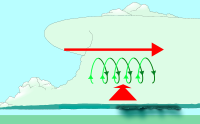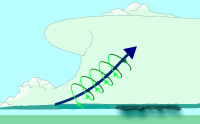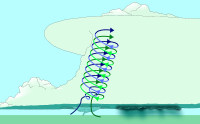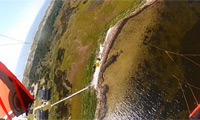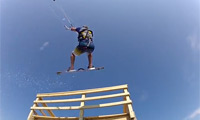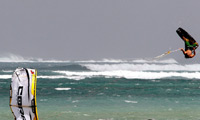It´s been a while since someone uploaded a decent video on vimeo. So I´m happy that some Victoria kiters made this nice video from their trip to Cape Hatteras in North Carolina. Nice shooting in a great scenery along with some cool tricks, that’s all that is needed to make a quality video to share with kiters all around the globe :)
When is it time to leave the water?
Under your kiteboarding lesson you probably learned that it´s important to keep an eye on the sky to see if there are any weird cloud formations going on such as dark clouds or cumulonimbus clouds. Rain fronts are usually easy to spot in time to manage to go back on land and bring down your kite before the front is over you. Or you can of course stay in the water and get prepared for an insane jumping session, just don’t lose your board since it can be difficult to recover it in very strong wind. Sometimes rain fronts come and go frequently and you can often see if it´s a big front or a smaller front. The size of the front determines how long you can expect the temporary strong wind to last. Landing a kite in strong gusty wind can be very dangerous, so it´s better to stay in the water and let the front pass than landing the kite while the wind is at its peak. If the whole horizont is dark and cloudy, then you might consider to get back on land after all even if you’re a skilled kiter, since you cannot estimate for how long the bad weather will last. There are however some occasions where you really shouldn’t stay in the water to prolong your kite session. One of these occasions is if the sky looks like this:
What you see here is a Shelf cloud which is a type of an Arcus cloud. This cloud could be seen in Hatteras yesterday the 22nd of May and I doubt that any kiteboarders decided to take a session during the time.
A shelf cloud is a horizontal wedge shaped cloud that rush forward along the ground. The shelf cloud is in turn connected to the base of a parent cloud, usually a thunderstorm i.e. a big cumulonimbus cloud, but it can be attached to other convective cloud types as well. The leading edge of the shelf cloud gets its characteristic shape due to the cold sinking air coming from the storm cloud behind it. This downdraft spreads out across the land as the leading edge is heading towards you. With this leading edge comes a strong gust front.
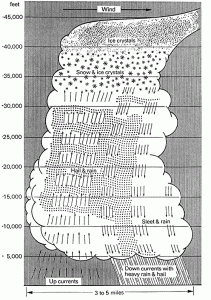 The storm cloud behind the shelf cloud might be very high (1,5 miles up to 14 miles) with strong upwinds. These upwinds are caused when the warm air in the middle of the cloud rushes upwards through the cloud. The cumulonimbus cloud often show up with its characteristic appearance of an anvil. The anvil consists of a veil of ice crystals in the upper part of the cloud, just at the bottom of the tropopause. The upwinds that reach this level is relatively colder than the tropopause, hence the moist air is diffusing laterally. This cold air in turn creates downdraft on the outside of the cloud. The rain and hail in these downdraft bring a lot of air that smashes towards the ground where it is being pushed forward in front of the cloud. This is the strong cold gust that we feel just before a bad weather cloud is coming in. The upwinds in the cumulonimbus clouds can be as strong as 20-30 m/s. They are therefore extremely dangerous to kiteboarders. In other words it´s not a good idea to be out kiteboarding either if you see a shelf cloud or a cumulonimbus cloud. There is a high risk that you get lofted, which happened to the guy from the unbelievable “Top Hat video”.
The storm cloud behind the shelf cloud might be very high (1,5 miles up to 14 miles) with strong upwinds. These upwinds are caused when the warm air in the middle of the cloud rushes upwards through the cloud. The cumulonimbus cloud often show up with its characteristic appearance of an anvil. The anvil consists of a veil of ice crystals in the upper part of the cloud, just at the bottom of the tropopause. The upwinds that reach this level is relatively colder than the tropopause, hence the moist air is diffusing laterally. This cold air in turn creates downdraft on the outside of the cloud. The rain and hail in these downdraft bring a lot of air that smashes towards the ground where it is being pushed forward in front of the cloud. This is the strong cold gust that we feel just before a bad weather cloud is coming in. The upwinds in the cumulonimbus clouds can be as strong as 20-30 m/s. They are therefore extremely dangerous to kiteboarders. In other words it´s not a good idea to be out kiteboarding either if you see a shelf cloud or a cumulonimbus cloud. There is a high risk that you get lofted, which happened to the guy from the unbelievable “Top Hat video”.
Massive cumulonimbus clouds can, if the conditions are right, transform into supercells. Supercells can be described as cumulonimbus clouds with strong rotating updrafts. The rotation occurs when the updrafts are combined with wind shear. The wind shear make the air turn into a huge vertical spiral inside the cloud that is being bended upwards thanks to the updrafts.
If you face a supercell when kiteboarding then you better not just head toward the beach asap, but packing down your stuff and get the hell out of there!
Cape Hatteras Kiteboarding
Ever been thinking of doing a roadtrip through the states? then you might wanna stop by Cape Hatteras in North Carolina. Here is NY kitecenter located (nykitecenter.com) who organize trips to the best kiteboarding spots in the area.
Related External Links
Hatteras 2012 Daniel Koenig and Stefan Koenig
Two for me unknown brothers, Daniel and Stefan Koenig, have shot this video in Cape Hatteras, North Carolina. It’s nice to for once see some innovative kitesurfing, not just the usual unhooked 1080’s ala Aaron Hadlow style :)
Related External Links
7 WORLD’S BEST KITESURFING SPOTS
7 WORLD’S BEST KITESURFING SPOTS
Kitesurfing is one sport that is now fast becoming popular. So many water sport enthusiasts have found new joy in the company of the sun, wind, and waves. For kitesurfers who are in search of amazing adventures all over the world, here is the list of the wonderful beaches with astonishing vistas and consistent winds.
 1. Cabarete, Dominican Republic
1. Cabarete, Dominican Republic
June’s third week is its best kite season thus, it hosts the largest competition for kiteboarding wherein hundreds of kitesurfers all over the world gather. Because it is considered one of the kitesurfing capitals in the world, this place offers professional instructors for beginners and amateurs. Also, advanced riders may take pleasure in testing its amazing waves and strong winds.
 2. Cape Hatteras, North Carolina
2. Cape Hatteras, North Carolina
This kitesurfing destination is among the best in the world. The best time to take an adventure in the Outer Banks is between April to November because the wind that blows in the area is perfect. Cape Hatteras offers enough space for new kitesurfers who wish to learn the basics and discover new tricks.
 3. Maui, Hawaii
3. Maui, Hawaii
Considered the world’s top kitesurfing destination, Maui provides year round kitesurfing season. The water temperature is 84ºF which makes it advisable for surfers to keep their wetsuit off. Maui’s location and windy days all year makes it perfect for kitesurfing because you won’t have to worry about beach space and weather condition.
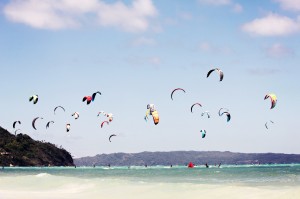 4. Boracay, Philippines
4. Boracay, Philippines
Not only does this place have an amazing beach space and wonderful wind best for kitesurfing, this paradise also boasts its fine white sand. Kitesurfers who would like to tour around after their sessions would certainly love this haven.
 5. Cape Town, South Africa
5. Cape Town, South Africa
The best kitesurfing season in Cape Town is during October until March. It is during this time when you will spot several kiters dancing on the water as they enjoy the waves and the wind. The wind is pretty much consistent during this time of the year thus, so many kitesurfers spend several days in Cape Town not just to surf but also to take pleasure in the panoramic scenery of Table Mountain.
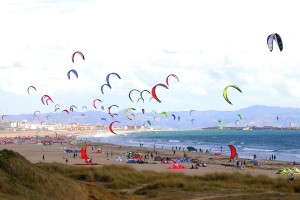 6. Tarifa, Spain
6. Tarifa, Spain
It won’t be called Europe’s wind capital for nothing. This southernmost part of Spain has become the fortress of kitesurfers. In fact, there are over sixteen schools for kiteboarding in Tarifa. Its weather condition has made it perfect for kitesurfing students especially during the summer.
 7. Hua Hin, Thailand
7. Hua Hin, Thailand
For water fun, this part of Thailand has become an ideal place as Hua Hin has remote beaches best for beginners and amateur kitesurfers. Also, there are several kite shops in the area which makes it more convenient for kiters.
These windy shores are guaranteed to amuse you but if you need more suggestions, you may also try to visit other destinations for kitesurfing such as Essaouira, Morocco, Gokova, Turkey, Cumbuco, Brazil, and Dahab, Egypt. If you worry that you have not tried kitesurfing yet, do not fret because kitesurfing schools are almost everywhere especially in places with great winds. So what are you waiting for? Pack your kitesurfing essentials and start flying!

